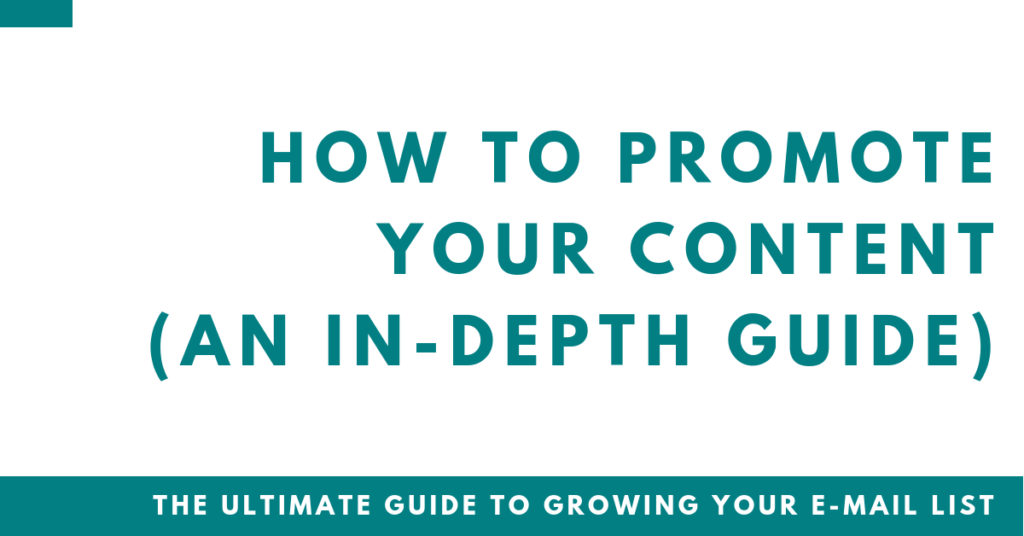
You’re currently reading Chapter 10 of The Ultimate Guide to Growing Your E-mail List.
To grow your e-mail list, you need to promote your remarkable content, ESPECIALLY when you’re just starting out with growing your e-mail list.
But how do you promote your content in a way that’s authentic, non-spammy, and doesn’t get people to hate you and kick you out of online communities in your industry?
That’s exactly what we’ll talk about this SUPER in-depth post.
In the first part of this post, we’ll cover IF and WHEN you should be promoting your content (the answer to that questions isn’t black and white), and we’ll also look at the 80/20 Content Promotion Myth.
In the second part of this post, we’ll take a detailed look at 21 proven content promotion strategies that you can start using today (as well as which strategies YOU should use in your business to create your own content promotion plan).
We’ll also break down and analyze countless real-world content promotion examples, such as a recent book launch of Best-Selling author Ramit Sethi.
Let’s dive in!
How much time should you spend promoting your content?
In one of his viral articles, Derek Halpern from Social Triggers famously said that you should spend 20% of the time writing Remarkable Content, and 80% of the time promoting it.
As I interviewed 20 established online entrepreneurs with e-mail lists of 1,000-40,000 e-mail subscribers to write this guide, I decided to put that technique to the test and see just how many entrepreneurs actually spend 80% of their time promoting their content.
In other words, do you really need to spend 80% of your time promoting your content to build an e-mail list of 10,000+ e-mail subscribers?
The surprising answer? Not necessarily.
For example, here’s what Peter Nguyen from The Essential Man said about content promotion:
“I used to share my content on Facebook, Tweet it out, share it on Instagram, e-mail people and ask them to share it, but it never really worked. It just wasn’t moving the needle for my business.
Now I just focus on creating awesome content for my readers, share it with my mailing list and optimize it for SEO. I also make sure the “Wikipedia Strategy” where I keep linking to my old content through all the new content that I create.
I play to my strengths and focus on writing and dominating SEO.”
Danny Margulies from Freelance to Win shares a similar story:
“I just focus on writing great content. All these other things, like “20% writing, 80% promotion”, I’m NOT a believer of them. I do almost no promotion, all of my creative energy goes into WRITING, pushing the bar. Some people are great at networking and promote their content, but I’m not so I don’t do it.”
Finally, Luke McIntosh said:
“I don’t do any content promotion. I just post my content. That’s the beautiful thing about YouTube. It does the work for you if you make good content.”
These are all entrepreneurs with tens of thousands of e-mail subscribers (and there are more examples like them – entrepreneurs like Geraldine Lepere and Christina Rebuffet also just post their content on YouTube, Rusty Gray just focuses on SEO…
So is the 80/20 Content Promotion Rule a myth? Not necessarily.
Through my interviews, I discovered that promoting your content DOES work, and it can be crucial to getting your online business off the ground.
Here are some great examples:
- Michelle Rebosio, went from 0 to 1,000+ e-mail subscribers in less than a month by creating an Epic Lead Magnet and promoting it through Facebook Groups
- Olivia Angelescu went from 0 to 400+ e-mail subscribers in a few days by creating an Epic Lead Magnet and sharing it in a Facebook Group
- Peter Nguyen got 1,000+ new e-mail subscribers through a Guest Post that linked back to an Epic Lead Magnet on his website
Content Promotion is a nuanced topic, and isn’t black and white.
It’s not true that you should always spend 80% of the time promoting your content. It’s also not true that you don’t need to promote your content.
Here’s what I can conclude based on all the data that I collected though.
There are 7 guidelines you can follow that will help you figure out exactly when you should go the extra mile with promoting your content and when you should skip content promotion altogether, based on how big your e-mail list is, your strengths, and the type of content you’re creating,
Should You Promote Your Content? Answer These 7 Questions
You can ask yourself these 7 questions to get a clear idea if you should promote a piece of Remarkable Content or an Epic Lead Magnet you just wrote using the techniques I’ll share in this post.
Q1: Is Content Promotion my Strength or Weakness?
To some online entrepreneurs, promoting their content comes pretty easily. Others would rather spend 3 hours at a dentist having their teeth pulled than to promote their content.
While you might have to “suck it up” and go through a few hours of content promotion when you’re starting out with growing your e-mail list (which, as Karen Dudek-Brannan says, is probably not as bad as working 40-70h/week in a job you hate), it doesn’t mean you’ll have to promote your content forever.
If content promotion is hard for you, use the tactics for overcoming your fear of self-promotion from the previous chapter of this guide to get to 500-1,000 e-mail subscribers. Then, once you have the critical mass of e-mail subscribers that can promote the content for you, you can focus on just creating more Remarkable Content like Danny Margulies or Peter Nguyen.
If, on the other hand, you find that content promotion comes easy for you (and brings you the results you want it to), you should by all means spend 80% of the time promoting your content and 20% creating it, ESPECIALLY if creating content feels harder to you than promoting it.
As a fun fact: When I spoke with Derek Halpern about his 80/20 Content Promotion Rule, he said that the reason he even came up with it was that a lot of people hated writing but wanted to grow their blog audience, so this rule specifically serves those people.
If you love writing but hate content promotion, that rule might not be the best rule for you to follow.
Q2: How big is my existing network?
If you’ve been working in an industry like International Development (Michelle Rebosio) or Speech Pathology (Karen Dudek-Brannan) for all of your life, and decide to turn it into a business, you’ll likely have a large professional network.
If you have a lot of existing relationships with people that might be able to spread the word about your content, you should absolutely let them know about any Remarkable Content you create to spread the word about it.
The same goes for when you grow your business and your business network – the more people you know, the easier it will be for you to promote your content.
But if you don’t know anyone in your industry yet, you might want to spend less time promoting your content (and perhaps more time building relationships with top experts in your industry, for which you should read The Ultimate Guide to Surrounding Yourself With Successful Entrepreneurs).
P.S. Did you just mention how I “casually mentioned” my Ultimate Guide here – that’s a form of content promotion as well!
Q3: How big is my e-mail list?
A trend that I noticed with online entrepreneurs that have 5,000+ or 10,000+ e-mail subscribers is that they generally spend very little time promoting their content, UNLESS it’s a piece of content that they spend tens or hundreds of hours creating.
By contrast, I noticed that they DID promote their content a lot more when they were just starting out with growing their e-mail list (until they came to a point of diminishing results, or decided to focus their time and energy into their strengths).
Most online entrepreneurs that have e-mail lists of tens of thousands e-mail subscribers simply publish their content, e-mail it out to their e-mail subscribers, then let them spread the word about it. Many of them focus some of their attention on SEO, which also helps them promote their content through Google.
If your e-mail list is still pretty small (less than 1,000 e-mail subscribers), I definitely recommend giving content promotion a shot (who knows, you might notice it’s actually not so bad or that you enjoy it) until you do get to 1,000+ e-mail subscribers, and you should definitely at least promote your Epic Lead Magnet.
But once your e-mail list grows and you see that every time you publish a piece of content it keeps getting traction for days or weeks to come, you can shift your attention to simply creating more content, rather than aggressively promoting it.
Q4: How remarkable is my content?
Not all content is made the same.
Promoting an Epic Ultimate Guide you spent 50 hours creating isn’t the same as promoting a blog post you put together in an hour.
If you put yourself into the minds of people who are exposed to your content through an online community, they’ll be a lot more excited about an Epic Ultimate Guide than a “decent” blog post (which they might consider spam without even reading it).
Same thing goes for e-mailing your network – if you e-mailed all of your professional friends every time you publish a blog post they might get sick of you / feel like you’re just using them – while if you only e-mailed them once a year when you created an incredible resource, they might be excited to help you spread the word about it.
Deep down, you know that. That’s why you’ll feel a lot more confident about promoting content that’s truly remarkable (that you spent hours and hours putting together). You know the work that went into it, and you know that people will notice it.
For example, content promotion definitely isn’t my strength, and I never do it for “regular” blog posts I write. But every time I write an Ultimate Guide, I take the time to spread the word about it. And with The Ultimate Guide to Growing Your E-mail List that I already spent 100+ hours creating, I’ll definitely take the extra time to promote it once it’s finished.
Though of course, I won’t follow the 80-20 Promotion Rule, as promoting it for 400+ hours would quickly lead to diminishing returns.
Q5: What is my main content platform?
There are certain platforms like Youtube, Quora, Reddit, Pinterest or Instagram that promote your content “for you”.
The entrepreneurs I interviewed that use YouTube as a main list-building strategy (Will Darling, Christina Rebuffet, Geraldine Lepere, Luke McIntosh and Sam Gavis-Hughson) might spend up to 20 hours creating a YouTube video, and then let the YouTube promote it to their audience for them.
For them, it makes more sense to spend another 20 hours creating another YouTube video than to promote their video on the internet (as they noticed that consistent publishing is one of the key ways to build your e-mail list through YouTube).
If, on the other hand, you’re publishing content on your blog and you don’t have an existing e-mail list that you can promote your content to (or your e-mail list is lower than 1,000 e-mail subscribers), then content promotion will be more important to build traction around your content.
Q6: What kind of results am I getting from content promotion?
“Double down on what works, and stop doing what doesn’t”.
That’s a golden piece of advice I got from one of my mentors, Ramit Sethi, a few years ago, and I still carry close to my heart.
This rule couldn’t be more true when it comes to content promotion.
I encourage you to try some of the different content promotion strategies that I’ll share in this chapter and just see what works and what you enjoy doing.
Do more of the strategies that work. Stop doing the ones that don’t.
Do more of the strategies you enjoy. Stop doing the ones you hate.
You don’t NEED to constantly use 20 strategies to promote your content, you just need to find the 1-2 strategies that work for you and use them over and over again.
And if you notice that promoting your content doesn’t make a difference for your business (like Peter Nguyen), then, by all means, just spend more time creating content instead of promoting it.
Q7: Can I create a snowball effect?
Some Epic Lead Magnets or pieces of Remarkable Content that you create in your business will take off more and faster than others. Some might even go viral!
Those pieces of content are the ones you should spend the extra time promoting, as you know that they resonate with your audience, as well as provide leverage for you to promote more easily.
If a piece of content is already getting a lot of love / views / shares, more people are likely to check it out and share it with others, and you can even mention that as you promote it.
Your goal with these pieces of content is to create a “snowball” effect that leads to more and more traction over time, rather than saying “oh this is doing well, so I don’t have to promote it”.
A quick recap of the 7 questions
By asking yourself these 7 questions:
- “Is content promotion my strength or weakness?”
- “How big is my existing network?”
- “How big is my e-mail list?”
- “How remarkable is my content?”
- “What is my main content platform?”
- “What kind of results am I getting from content promotion?”
- “Can I create a snowball effect?”
You can more easily determine if you should promote a piece of content on a “case-by-case basis”.
If content promotion is your strength, spend more time promoting content.
If you have a big network in the industry, spend more time promoting content.
The bigger your e-mail list, the less you need to promote your content.
The more remarkable your content, the more time you should spend promoting it.
If you are publishing your content on a platform with an existing audience like YouTube, focus your energy into creating more content rather than promoting it.
If content promotion is significantly helping your grow your e-mail list, keep doing it – if not, spend more time creating content (or revisit your business idea).
If a piece of content starts to gain a lot of traction, spend extra time promoting it to create a snowball effect.
Ok – now you should have a LOT more clarity around whether you should promote your content or not.
Now let’s talk about the actual strategies for promoting your content!
21 Simple and Effective Content Promotion Strategies
In the first part of this post, we talked about if (and when) you should be promoting your content.
We concluded that you should indeed promote your content, especially if you’re at the early stages of growing your online business and have less than 1,000 e-mail subscribers (though you might be able to get away with less content promotion as your business grows).
Once you’ve written your Epic Lead Magnet or the first few pieces of Remarkable Content, promoting your content can help you go from 100 to 500-1,000 e-mail subscribers over the course of a few weeks.
In this chapter, we’ll go over 20 content promotion strategies that will help you authentically promote your content to the right people, without feeling sleazy or spammy or getting banned from online communities.
The Content Promotion Matrix
Here’s where these strategies fall visually on the Content Promotion Matrix:
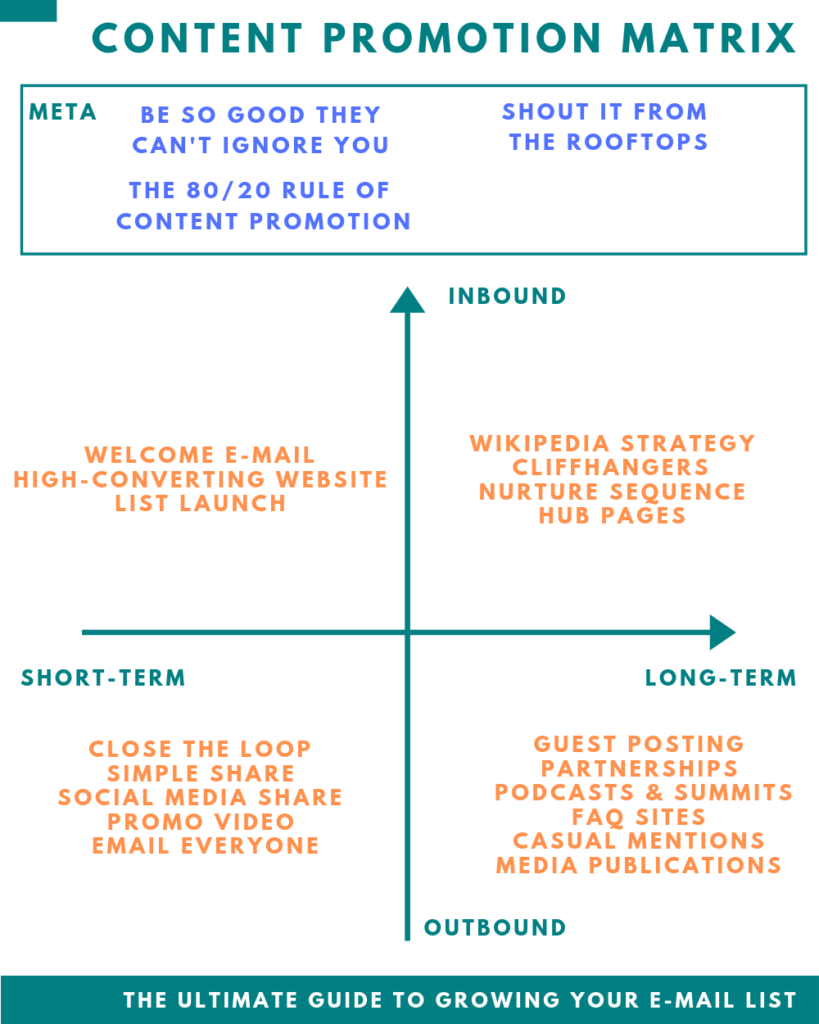
Since 21 strategies is A LOT, I organized them into different categories for you.
First, we’ll go over 3 “meta-strategies” that you should always keep in mind when promoting your content:
- Be So Good They Can’t Ignore You
- Shout it From The Rooftops
- The 80/20 Rule of Content Promotion
Then, we’ll go over the remaining 18 strategies which I organized into 4 different categories for you:
- Inbound Short-Term Promotion: You will use these quick & easy strategies to promote your content to your EXISTING audience
- Inbound Long-Term Promotion: You will use these strategies that require a larger time commitment to promote your content to your EXISTING audience
- Outbound Short-Term Promotion: You will use these quick & easy strategies to reach NEW audiences
- Outbound Long-Term Promotion: You will use these strategies that require a larger time commitment to reach NEW audiences
I organized split these into inbound/outbound strategies (outbound strategies will typically require you to promote your content outside of your website / e-mail list, while inbound strategies will help you to promote your content within your website / e-mail list).
I also organized them into short-term and long-term strategies (short-term strategies are strategies that are quick & easy to execute, while long-term strategies are strategies that will require a bigger time commitment, or that you’ll keep implementing over and over again).
Meta-Strategies:
- Be so good they can’t ignore you
- Shout it from the rooftops
- The 80+20 rule of content promotion
Inbound Short-Term Promotion:
- Welcome e-mail
- High-converting website
- List Launch
Inbound Long-Term Promotion:
- Wikipedia strategy
- Cliffhangers
- Nurture sequence
- HUB pages
Outbound Short-Term Promotion:
- Close the loop
- Simple share
- Social media share
- Promo video
- Email everyone
Outbound Long-Term Promotion:
- Guest posting
- Partnerships
- Podcasts & summits
- FAQ sites
- Casual mentions
- Media publications
Ok, let’s dive in!
Content Promotion Meta-Strategies
Let’s kick things off with two “meta-strategies”. These are two principles you should always keep on top of mind as you’re promoting your content, regardless of which content promotion strategy you’re using:
- Strategy #1: Be So Good They Can’t Ignore You
- Strategy #2: Shout it From The Rooftops
- Strategy #3: The 80/20 Rule of Content Promotion
Strategy #1: Be So Good They Can’t Ignore You
Yep, this is a reference to Cal Newport’s phonomenal book, So Good They Can’t Ignore You. While this book is all about excelling in your career, I feel like the same principles apply to creating and promoting your content.
Remember these two quotes from the last chapter on “putting yourself out there:
Ryan Hildebrandt said:
“When you’re afraid to put your content out there, sometimes your content just isn’t that good / unique. The solution isn’t to work on your mental game, it’s to write better content.”
Karen Dudek-Brannan shared Ryan’s opinion:
“I know my content. If you are confident in your solution, you can say “I know my stuff, this works, I validated it myself”, if I know what I have is what people needed.”
When it comes to Content Promotion, creating Remarkable Content or a truly EPIC Lead Magnet is 90% of the battle.
When you’re creating content, your goal should be to create the “single best piece of content out there”, which will absolutely require you to go the Extra Mile.
What I noticed from my own experience is that when I create content that I KNOW is by far the best out there:
- A lot more of my readers share and recommend it to their friends on their own
- It’s a lot easier for me to put myself out there and promote it
- A lot more people will notice how good the content is and appreciate it
Promoting a remarkable piece of content will feel completely different than a mediocre piece of content.
Think about the last time you read a great book. You probably shared it with your friends or talked about it because it was so good, right?
On the flip side, if you read a book that was just “okay”, you wouldn’t really recommend it to anyone, even if the author themself asked you to do it.
Before you apply the strategies in this chapter of the guide, make sure you took the time to create content that’s so good it can’t be ignored.
Strategy #2: Shout it From the Rooftops
What about when you DID spend hours and hours creating an incredible piece of content that you just KNOW that people need to know about?
That’s when, as Sam Gavis-Hughson would say, you “shout it from the rooftops”:
“Once I finished my free e-book, I went into free Facebook groups, reddit, wrote a few blog posts about the e-book, even guest posted about it. I always talked about the FAST strategy (shouted it from the rooftops), but only shared additional examples etc. in the e-book.”
When you spent 20+ hours creating something incredible, people NEED to hear about it. That’s why you should use every opportunity you get to talk about your Epic Lead Magnet or Remarkable Content, and genuinely “shout it from the rooftops”.
Strategy #3: The 80/20 Rule of Content Promotion
Something that kept coming up over and over again in the interviews that I did for this guide is the 80/20 Rule of Content Promotion:
You should only focus on a few content promotion strategies that work for you, while ignoring all others.
For example:
- Peter Nguyen said that Facebook, Instagram, Twitter, and asking people to share his content never really worked for him (but a guest post brought him 1,000+ e-mail subscribers)
- Danny Margulies happily ignores most content promotion strategies, but attracted thousands of e-mail subscribers through Guest Posting and Media Publications
- Luke McIntosh tried using Facebook Groups and Reddit to promote his content which didn’t really work, but built an e-mail list of 25,000+ e-mail subscribers through YouTube videos
While I share 18 specific content promotion strategies in this guide, chances are only a handful of those will work for you (and you’ll enjoy doing). Instead of trying to do EVERYTHING, experiment and find a handful of tactics that work well for you, keep doing them, and ignore all others.
Inbound Short-Term Content Promotion Strategies
Ok, let’s talk about some of the more practical content promotion strategies. First, we’ll talk about inbound short-term strategies.
These are quick & easy strategies that you can use to promote your content to your EXISTING audience and generate some initial traction and word-of-mouth with every piece of content you publish:
- Strategy #4: Welcome e-mail
- Strategy #5: High-converting website
- Strategy #6: List Launch
You’ll use these strategies through your own website or e-mail list (whether you have 100 or 10,000 e-mail subscribers).
Strategy #4: Welcome E-mail
If you went through the steps of the previous chapter on setting up your e-mail list, your welcome e-mail or incentive e-mail should already invite your readers to read your Epic Lead Magnet.
This means that every single new person that subscribes to your e-mail list will have the opportunity to read your best content.
Once you have more than one Epic Lead Magnet or a few pieces of really popular Remarkable Content, you can work those into your welcome e-mail as well.
Here’s a great example from Nagina Abdullah’s Welcome E-mail:
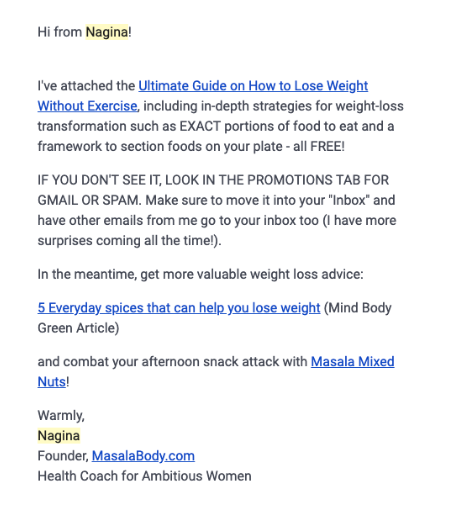
In her e-mail, Nagina lets you know about two popular blog posts on her website (5 everyday spices that can help you lose weight and the masala mixed nuts recipe) as soon as you subscribe to your e-mail list.
If 100 new people subscribe to your e-mail list over a course of a week, that’s 100 opportunities to put your best content in front of your new readers who are eager to learn from you. That’s 100 opportunities for your new readers to read, love and share your content with their friends (and promote it FOR you).
Strategy #5: Your High-Converting Website
The final short-term inbound content promotion strategy is to sprinkle your best content throughout your website.
Your Epic Lead Magnet should be in the front and centre of your website, and all of the roads should lead to it.
Here’s a great example from Peter Nguyen.
As soon as you come to his website, you’ll get the chance to download his Ultimate Spring Style Guide:
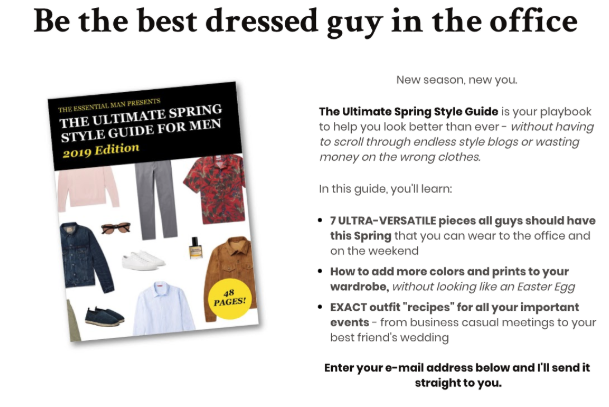
Then, as you continue to his blog page, you can find his guides through his menu on the top of the website:

As well as the sidebar on his blog:
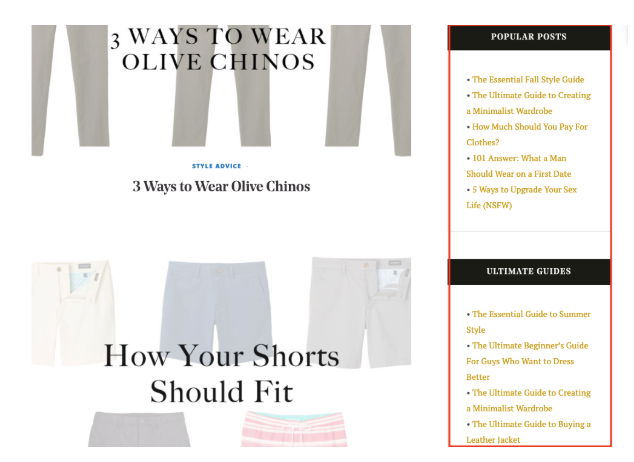
We’ll cover all the specific places where you should include your Epic Lead Magnets in more detail in the chapter on creating your High-Converting Website.
For now, all you need to know is that whenever you create a new piece of Remarkable Content you want to spread the word about, it should be accessible within 1-2 clicks from any page on your website.
Strategy #6: List Launch
Whenever you publish a new piece of content on your website, the very first thing you should do is e-mail your e-mail subscribers about it.
This is what I call the “List Launch”. Instead of launching your online course or a coaching product, you’re launching a new piece of content to your e-mail list, and you should treat it with the same rigour as you would treat a product launch.
You should go through this step regardless of whether you have 100 or 10,000 e-mail subscribers.
You can launch your content to your e-mail list in a number of different ways:
- The single e-mail launch
- The 5-day launch
- The EPIC launch
Which of these launch formats you choose will depend on the type of content you created.
The single e-mail launch:
This is the launch format you’ll most commonly use (probably in 80-90% of the cases), every time you publish a new piece of Remarkable Content.
For example, when I published my Ultimate Guide to Creating Content That Sticks, I sent a single e-mail to my e-mail subscribers:
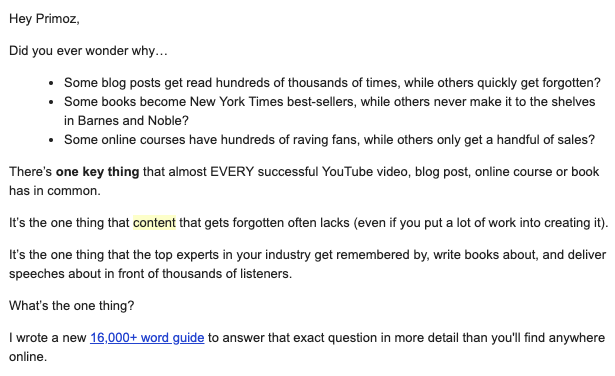
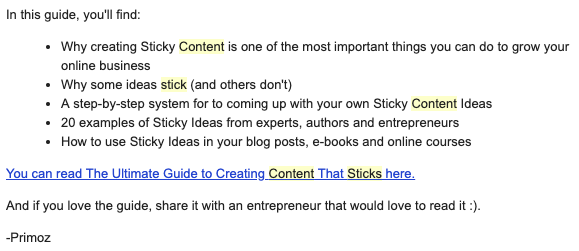
When I recently wrote a blog post about Temi, a transcription tool that I love, I wrote a similar e-mail to my e-mail list:
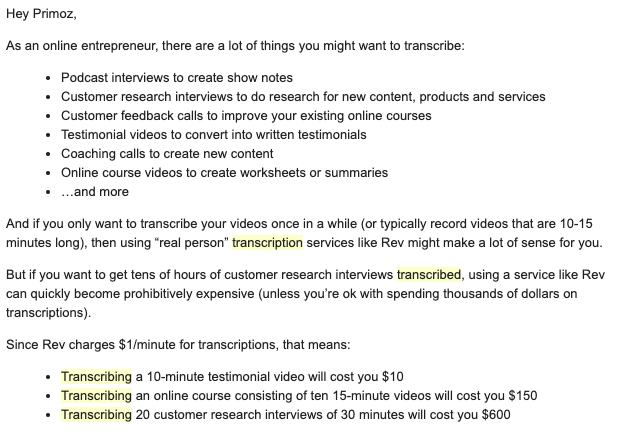
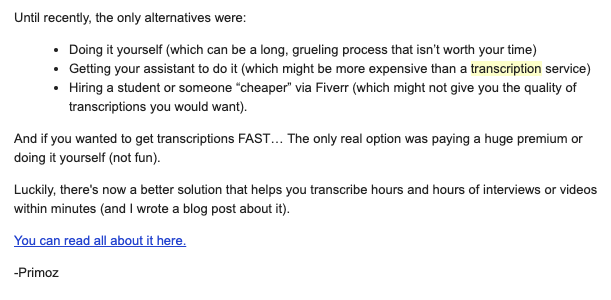
Whenever you publish a new blog post, the single e-mail launch should be your go-to way for sharing your content with your e-mail subscribers.
You can simply talk about:
- Problem Worth Solving: The problem(s) that your new piece of content solves
- Tangible Outcomes: How your readers will benefit from reading this new piece of content
- Remarkable Content: Invite your new readers to read (and share) your new content
If we apply the above framework to my second example, it would look something like this:
- Problem Worth Solving: You have a lot of interviews you want to transcribe, but it’s time consuming or prohibitively expensive
- Tangible Outcome: Transcribe hours and hours of interviews within minutes, at 1/10 of a cost of regular transcriptions
- Remarkable Content: Check out my new post about Temi, this amazing transcription tool
Writing an e-mail like this should only take you 10-20 minutes, and will be a great option for most of your content.
The exception is when one of your pieces of content gains a lot of traction – in that case, you might want to follow up this e-mail with a few e-mails that acknowledge that and invite your readers to read it if they haven’t done so yet.
Here are some examples of follow up e-mails I could write for my Ultimate Guide to Creating Content That Sticks:
- “This is how Jack wrote a blog post that got 200,000+ views”: I could share a story about how one of my readers used my guide to get a Tangible Result (and invite others to read the guide as well)
- “This is what people are saying about my sticky idea guide”: I could share a few raving comments on my guide with my e-mail list (and invite my subscribers to read it)
- “How to come up with your sticky idea in 7 easy steps”: I could point my readers to a specific chapter in the guide (that they might not have read yet)
The general rules here are:
- The more your piece of content takes off, the more e-mails you should send about it (the snowball effect) as you’re likely to reach exponentially more people.
- The more work you put into a piece of content (or the more detailed it is), the more interesting e-mails you can send to your e-mail list about it.
For example, if I wanted to, I could definitely send out more e-mails about my Ultimate Guide to Creating Content That Sticks (or even turn it into a 5-day launch if I chose so), since it’s deep enough to create 3-5 strong e-mails about it, and got great feedback from my audience.
My blog post about Temi on the other hand is a lot less detailed, so it might not make sense to spend as much time promoting it to my audience.
The 5-day launch
The 5-day launch is the next “level” of a launch, and will usually include sending 3-5 e-mails about your new piece of content to your e-mail list over the course of 5-7 days (sometimes longer).
You’ll want to use the 5-day launch for your Epic Lead Magnets and Remarkable Content that you spent 20+ hours creating, that you really want to “shout from the rooftops”.
If you took the time to create this incredible resource, you want to give it all the attention it deserves so it can reach as many people as possible, and for that, sending a single e-mail is not enough.
You should launch your Epic Lead Magnets (or Remarkable Content) in a similar way as you would launch a new online course that you spent hours and hours creating (and you could even launch it in a similar way).
Your 5-day launch will consist of 3 parts:
- Anticipation: You’ll spend 1-3 e-mails building anticipation and suspense around your Epic Lead Magnet (or even have your readers contribute to it)
- Reveal: You’ll reveal your Epic Lead Magnet to your e-mail subscribers with a BIG BANG
- Follow up: You’ll follow up with 1-3 e-mails with success stories from your Epic Lead Magnet, BONUS chapters and resources, or raving comments about it
Here’s a great example of a 5-day launch from Heidi Sew from Successful Fashion Designer for her Ultimate Guide to Creating Your Fashion Portfolio.
This 5-day launch was extended over a few weeks (rather than a few days), but follows the same principles we talk about here.
First, she sent out an e-mail asking her readers for resources to include in her guide (anticipation e-mail):
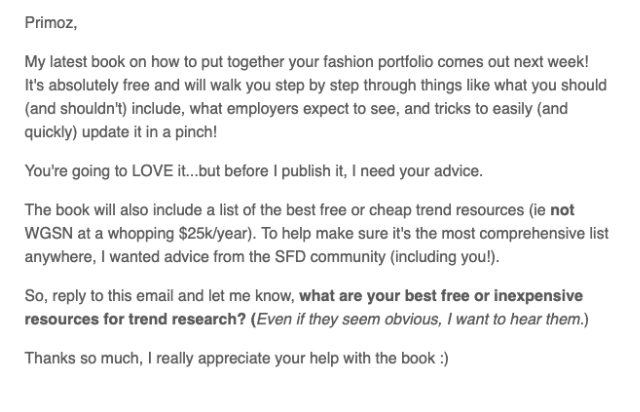
Then, she sent a P.S. in one of her Podcast e-mails further “planting the seed” about her guide (second anticipation e-mail):

In her third e-mail (The Reveal), she revealed her new guide:
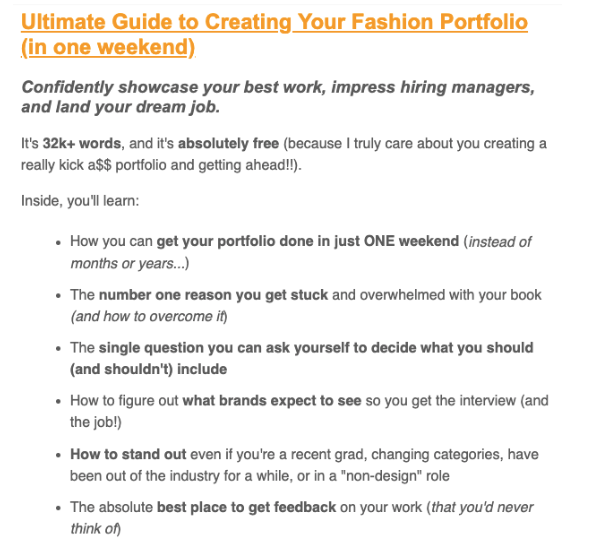
After the reveal, she sent a Follow Up E-mail about a BONUS chapter of her guide:
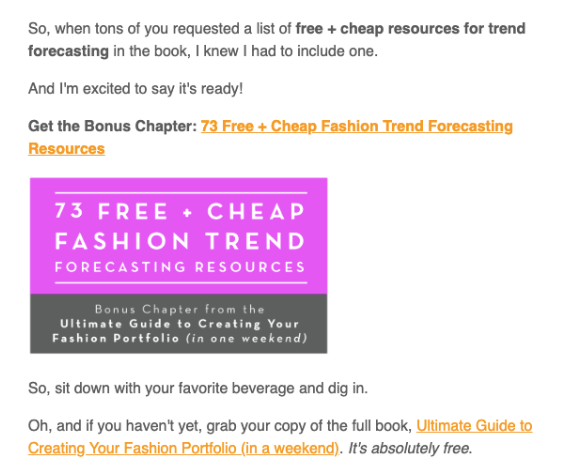
And another Follow Up E-mail where she mentioned the guide and shared an extra video related to her guide:
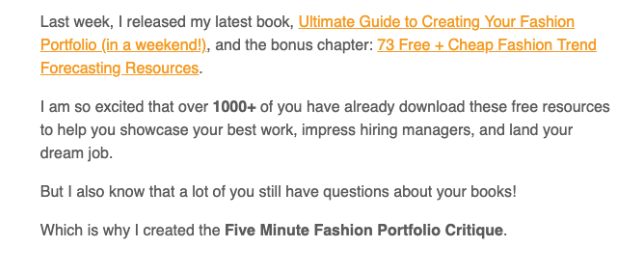
Her 5-day launch sequence looked like this:
- Anticipation:
- Email #1: Can I get your advice for my guide?
- Email #2: P.S. my guide goes live this Friday!
- The Reveal:
- Email #3: The guide is live!
- Follow Up:
- Email #4: Get the bonus chapter of the guide!
- Email #5: Here’s a video related to the guide
This way, she was able to generate a lot more buzz around her guide than she would with a single e-mail launch.
Let’s say that like Heidi, you’ve spent 20+ hours developing an Ultimate Guide for your readers.
In your Anticipation E-mails, you can:
- Send out a survey related to the guide
- Ask your readers what they’d like you to cover in the guide
- Share a “preview chapter” of the guide
- “Plant the seed” when the guide will be launching
These will get your readers excited and talking about the guide before you even launch it. It’s like knowing a week in advance that you’ll go to this amazing restaurant, rather than just deciding you’ll go there spontaneously. This way, you get to really savour the experience days before.
In your Reveal E-mail, you can:
- Reveal your guide
- Talk about the Problems Worth Solving and Tangible Outcomes related to the guide
- Ask readers to comment on it or share it
This e-mail is very similar to the single e-mail launch, and it’s also the most straightforward e-mail to write as your guide will do most of the work for you.
In your Follow Up E-mails, you can:
- Share BONUS chapters or resources of the guide
- Talk about the results of your readers that successfully used your guide
- Share Raving Comments on the guide
- Create and share follow-up resources (videos, blog posts or other resources) related to the guide
- Ask your readers for the feedback on the guide (what they liked, and what they didn’t like)
Typically, you’ll want to send out:
- 1-2 Anticipation E-mails
- 1 Reveal E-mail
- 1-2 Follow Up E-mails
Though it’s totally fine to tweak these guidelines to your situation. There’s nothing wrong with sending out 3 Anticipation or Follow Up E-mails!
The larger your audience, the more e-mails it makes sense to send. If you have only 100 e-mail subscribers, you might want to send a few less e-mails (as sending extra e-mails will bring diminishing returns).
If you have LESS than 100 e-mail subscribers, you should be focusing on getting to 100+ e-mail subscribers, rather than sending out e-mails to your existing e-mail subscribers.
However, if you already have thousands of e-mail subscribers, sending out 5 e-mails to promote your guide to your audience makes perfect sense.
The EPIC Launch
Finally, we have an “EPIC” Launch format.
This is a launch that typically stretches out over a few weeks where you’ll send 5+ (or tens of) e-mails to your audience about your new resource. The EPIC Launch will usually be very similar to launching a book, with a lot of build up and follow up e-mails.
I recommend doing an EPIC launch once:
- You already have an audience of hundreds (or thousands) of e-mail subscribers
- You’re releasing an in-depth EPIC resource that you spent 50+ or 100+ hours creating
You can think of the epic launch as an extended 5-day launch. You’ll follow the same framework for Anticipation, Reveal, and Follow Up E-mails, though there might be a lot more of those e-mails.
Because your resource will be insanely detailed, you’ll have plenty to talk about in those e-mails.
One additional element of an EPIC Launch are EPIC Events.
These are events that typically engage your community, get your readers to talk about your new resource and help you spread the word about it.
Here are some examples of EPIC Events.
- You could do a “launch party” once the resource is live – a live call where you talk about the resource and answer questions about it
- You could do a “challenge” around your resource, like Gabriela Pereira’s Book Club where she walks her readers through her book
- You could start a Private Facebook Group where your readers go through your resource, discuss it and give you feedback on it
- You could offer critiques or makeovers to your audience (for example, if you were a stylist, you could offer 3 of your readers live style makeovers)
- You could do a Q & A call a week after launching the resource where you coach your readers on the same topic as the resource
The sky is the limit here. You can have fun with this process, run experiments, and see which EPIC Events resonate with your audience.
Here’s a great example of an EPIC Launch from Ramit Sethi, who recently launched his updated book on personal finance. 90% of these e-mails talk about his book.
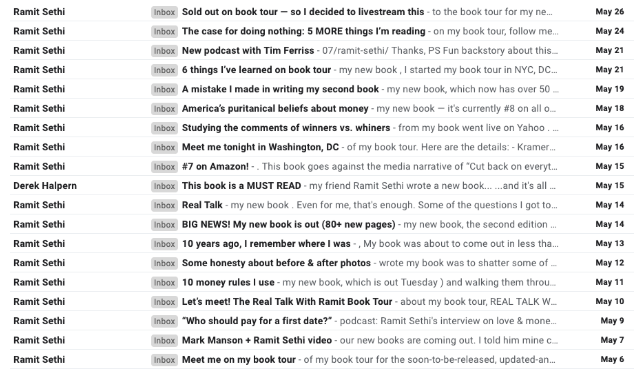
And since I love going into the trenches on case studies like this, let’s look at the most interesting parts of his launch.
Anticipation E-mails:
In the first e-mail, titled “guess what happened 10 years ago?”, he revealed that he wrote his book 10 years ago:
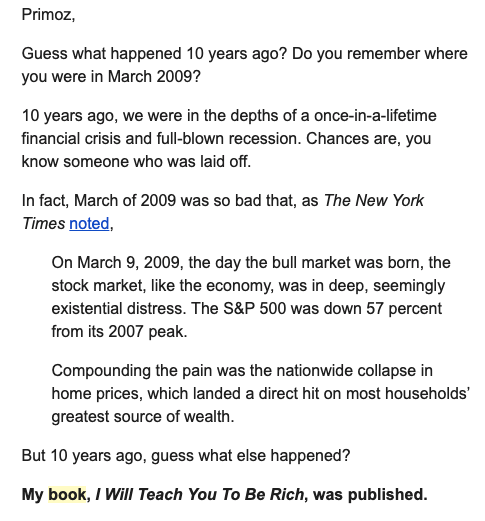
He shared a few interesting “behind the scenes” stories:
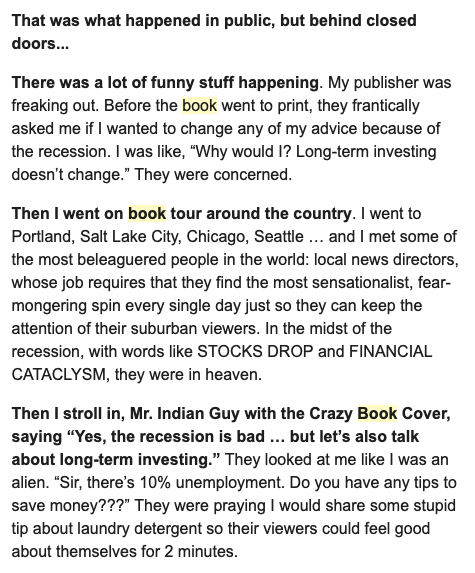
He wraps up the e-mail by inviting his readers to share success stories from his book and hints at a big announcement:
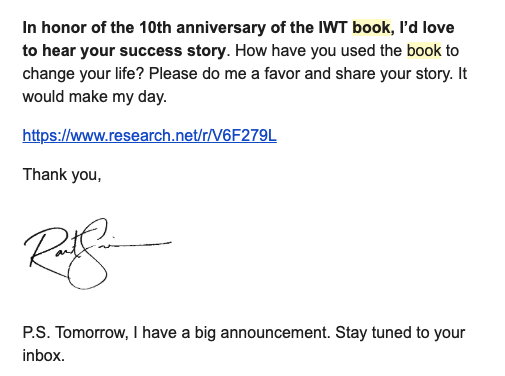
In the second Anticipation E-mail, he announces his new, updated version of his book:
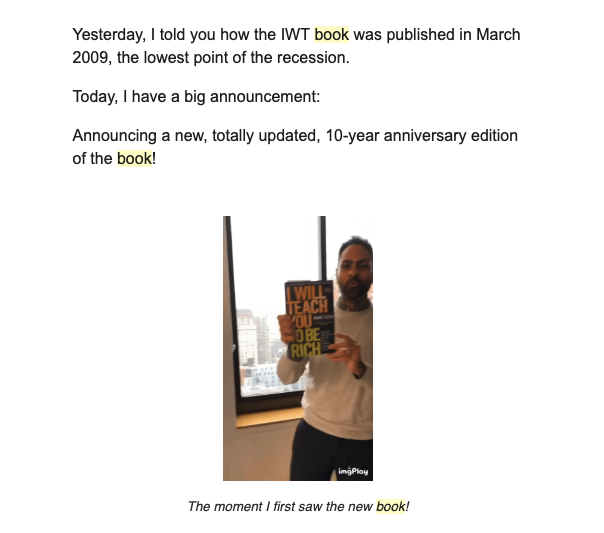
He also includes two EPIC events in his e-mail. First, he lets his readers know that they’ll get access to a handful of videos from his online courses if they pre-order the book:
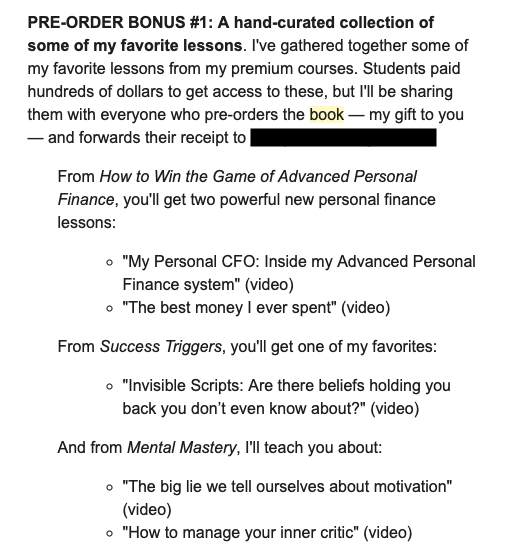
As well as an opportunity to be coached by him through a Private Facebook Group:
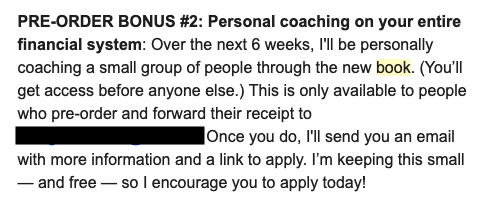
In his next Anticipation e-mail, Ramit invited his readers to his book tour:
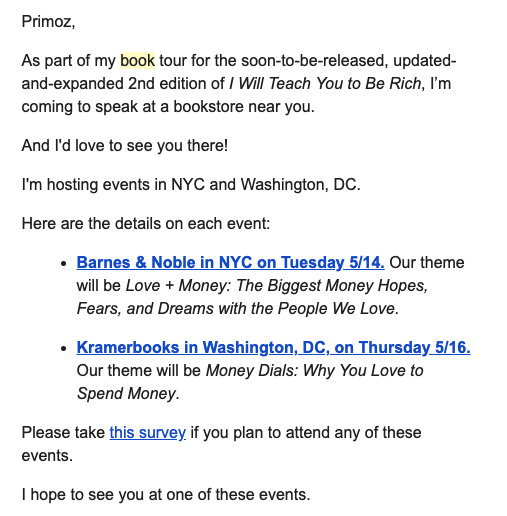
Another interesting EPIC Event was his interview with Mark Manson about the book (he also shared a few other interviews after this one):
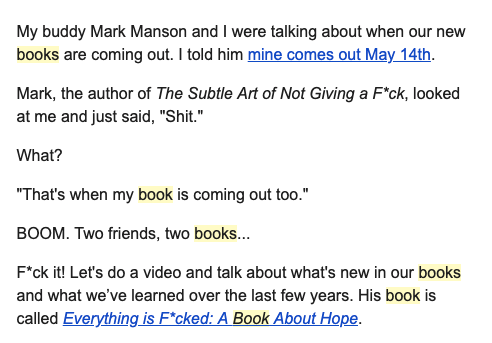
He then shared a nation-wide book tour:
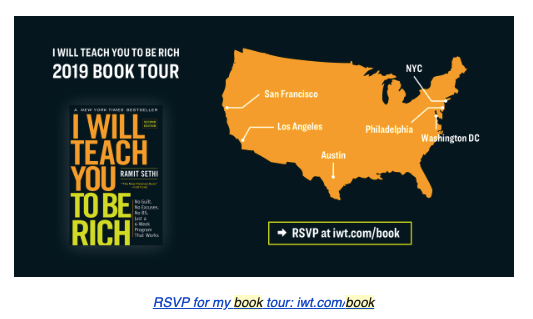
In his Reveal E-mail, he announces that the book is live, and invites you buy a copy (or 5) of his book:
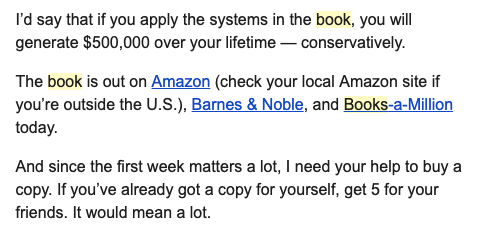
In his first Follow Up E-mail, he announces a LIVE Q & A that he’s doing online:
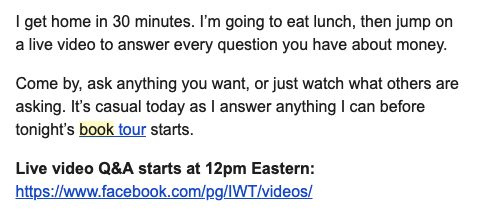
In his first Follow Up E-mail, he announces a LIVE Q & A that he’s doing online:
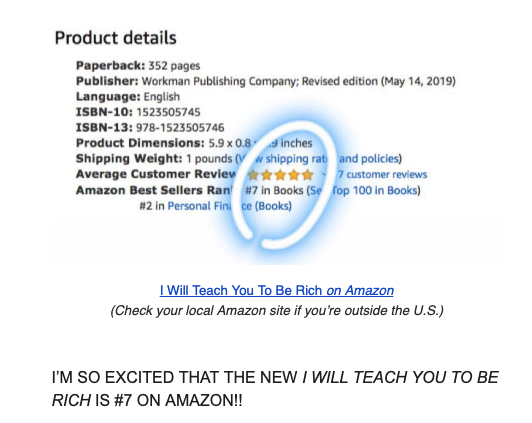
Then, he writes about a “mistake he made when writing the book”:
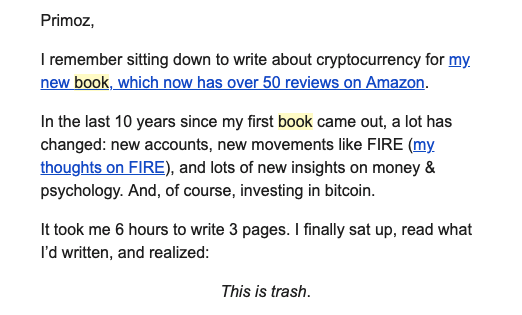
In his next e-mail, he shares “6 lessons he learned on his book tour”:
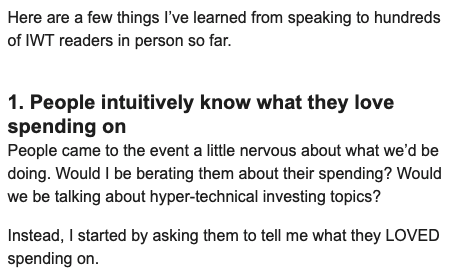
And in his final e-mail (so far), he shares that he’s live-streaming his sold-out book tour event:
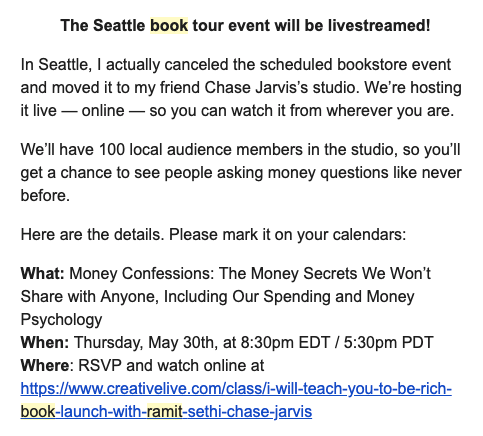
WOAH, that was a lot, right!?
Don’t worry, you don’t need to write 30+ e-mails about your next guide or fly all over the country to promote it.
But I thought I’d show you a great example of how a master promotes content that he spent hundreds of hours creating, and show you that he follows the exact same frameworks we are talking about in this guide.
You might also get some of your own ideas for your own Epic Launches ;).
Here’s a quick recap of most interesting elements of Ramit’s book launch:
- Anticipation: I wrote a book 10 years ago, big announcement tomorrow
- Anticipation + EPIC EVENTS: New book coming up, pre-order it and get access to a few course videos + private facebook group opportunity
- Anticipation + EPIC EVENT: Come to the book tour!
- Anticipation + EPIC EVENT: Podcast interviews talking about the book
- The Reveal: The new book is live! Buy a few copies
- Follow up + EPIC EVENT: Live Q & A
- Follow up: Book is #7 on Amazon!
- Follow up: A mistake I made writing the book
- Follow up: 6 lessons I learned on book tour
- Follow up + EPIC EVENT: Book tour live stream
Pretty awesome, huh?
While not quite on the same scale as Ramit’s book launch, I’m also doing an EPIC Launch for my Ultimate Guide to Growing Your E-mail List.
If you’re subscribed to my e-mail list, you might have noticed that:
- I sent out a survey about list-building to write a guide you love
- Hinted at releasing the guide in a few of my e-mails before the release
- I’m sending you each chapter of the guide as it’s written
- Asked for your feedback on the guide so I can make it even better
And in the future weeks, there will be a few EPIC events as well:
- There will be a big “launch party” once the guide is finished
- I’m doing a “website critique challenge” for my e-mail subscribers over the next few days
- And a few other surprises that I won’t share yet
While a big book tour across the country might be out of reach to you for now, you could DEFINITELY host a few EPIC Events like these next time you launch an Epic Lead Magnet to generate more buzz around it.
Inbound Long-Term Content Promotion Strategies
Ok, let’s talk about long-term content promotion strategies.
These are long-term strategies that you can use to promote your content to your EXISTING audience and generate additional streams of traffic throughout your website for years to come.
This strategies will help you make sure that the content you create doesn’t get lost in the trenches of your website, and that your new readers can find your best content you’ve written months (or years) ago.
Here are the strategies that we’ll cover in this section:
- Strategy #7: Wikipedia strategy
- Strategy #8: Cliffhangers
- Strategy #9: Nurture sequence
- Strategy #10: HUB pages
Let’s dive in!
Strategy #7: Wikipedia Strategy
When I talked to Peter Nguyen from Essential Man how he promotes his content, he said:
“I used to use Facebook, Tweet, Instagram, email people, ask them to share it (which never really worked), but these strategies weren’t moving the needle.
Now I share it with my mailing list and just optimize for SEO. I just create awesome content, and make sure my readers can talk about old content I’ve written
I also use the Wikipedia Strategy. Because I spend so much time creating awesome content, I link to my old content in my new content and consistently share it in my newsletter.”
To make sure your readers find your old content, think of your website as a Wikipedia where everything is connected, and your new posts link to old relevant posts.
You’ll see me do that through-out this guide.
For example, here’s an excerpt from my chapter about writing Mouthwatering Opt-in Copy:
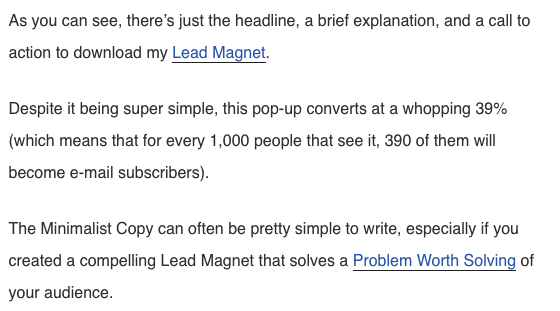
You’ll notice that I link to other chapters of the guide about Problems Worth Solving and Lead Magnets where relevant. That’s so that if someone stumbles upon my Opt-in Copy chapter, they can read my other relevant chapters as well, get more value from my advice, and more likely become my e-mail subscribers.
Here’s another great example from Danny Margulies’s post on 50 ways to compete with more experienced freelancers:
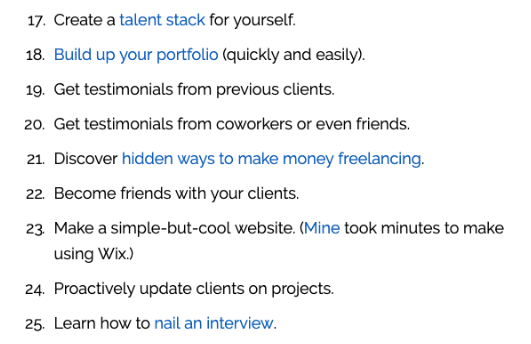
In his post, the majority of the links lead to existing content he’s written on his website – so if this post gets a lot of traction, a lot of his old content will benefit from that new stream of readers as well.
Whenever you’re writing a new piece of content, always think about how you can include references and links to your existing content in it, so you can continue to drive traffic to it for years to come.
The more content you write, the more you’ll be able to “interlink” your content like a huge web, eventually turning your website into a mini-wikipedia your readers love using.
Strategy #8: Cliffhangers
If you ever watched or read Game of Thrones (well, let’s ignore the last season), you probably had a love/hate relationship with it’s cliffhangers.
When an episode of the show ended JUST as something critical was about to happen, and the next season would start in a year… You know you’d be there after a year, dying to know what happens next.
These “cliffhangers” are amazing ways to keep the attention of your audience, and also a secret to creating high-converting Opt-in Copy and Lead Magnets.
Once you create your Epic Lead Magnet, you should always use it as a cliffhanger at the end of the Remarkable Content you create, like your blog posts or YouTube videos.
This won’t just help you rapidly grow your e-mail list and maximize your opt-in rate, it’s also a great way to keep putting your old Epic Lead Magnets in front of new readers.
Here’s a great example of the Cliffhanger Strategy in action.
Christina Rebuffet from Speak English with Christina created this YouTube video on How to Start a Conversation in English With Anyone.
At the end of the video, she talks about (and even SHOWS) her American English Survival Kit to her viewers:
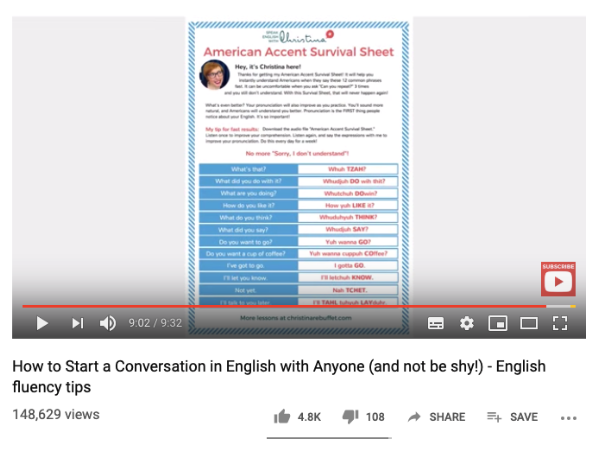
And now that they’ve seen it, they’ll want to download their own copy.
Here’s one of my personal examples, from my post about how to plan your year in 20 minutes. In this post, I talk about my annual review system and how to use it – but you can only get access to it if you subscribe to my e-mail list:
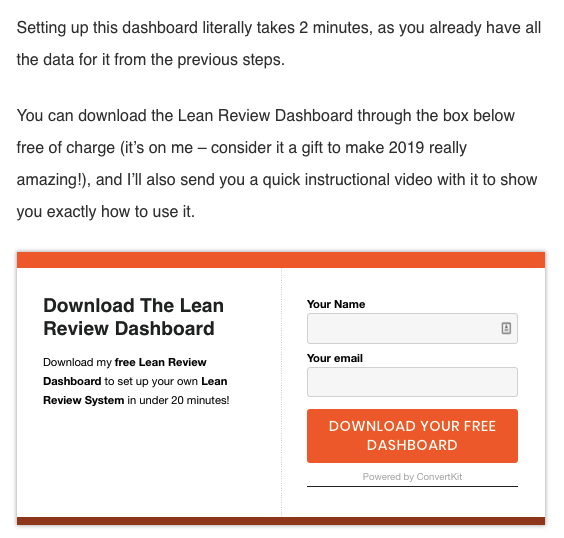
This simple system has been downloaded and used by hundreds of entrepreneurs (and I can continue referencing it any time I talk about how I plan my weeks/months/years).
Finally, a great way to create Cliffhangers in your Remarkable Content is to point at specific techniques, modules or pages in your Epic Lead Magnets.
Once this guide is finished and I will use the PDF version of it as an Epic Lead Magnet to future content I create, I can create a cliffhanger like “You can learn how to maximize your opt-in rate through the Cliffhanger Strategy on page 183 of this guide”.
The extra specificity makes the other side of the cliffhanger just one step away, making it even more compelling for your readers.
Strategy #9: Nurture Sequence
The Nurture Sequence is an advanced content promotion strategy you can use once:
- You already have a few thousand e-mail subscribers
- You already have 10-20 pieces of Remarkable Content
I wouldn’t really recommend investing your time into building out a Nurture Sequence before that as your time would be better spent creating more GROWING your e-mail list through Remarkable Content, Content Promotion and Epic Lead Magnets, rather than trying to ENGAGE it.
You also need to have created a decent amount of content in order to actually know which content performs best (so you can really share your most valuable content with your new readers).
So what is a Nurture Sequence?
A Nurture Sequence is a sequence of multiple Welcome E-mails you can send to your e-mail subscribers once they sign up to your e-mail list. This sequence helps you “nurture” your new e-mail subscribers, and get them to know, trust and like you through some of your best content.
You can think of the Nurture Sequence as an extension of your Welcome E-mail – instead of sending your e-mail subscribers a single e-mail, you can write 3-5 additional e-mails to them that you typically send to them over the course of 1-2 weeks.
Here’s a GREAT example of a Nurture Sequence from Geraldine Lepere, which is also her “Double Your Frenchness” Epic Lead Magnet:
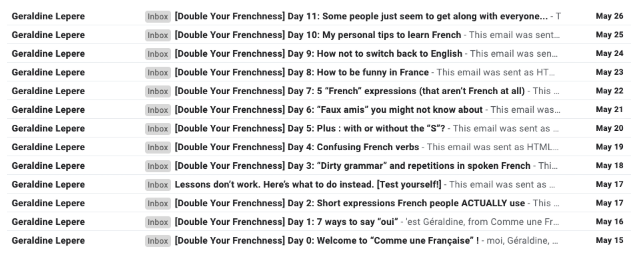
Over the course of 11 days, Geraldine sends you a set of 12 e-mails that walk you through some of her best YouTube videos:
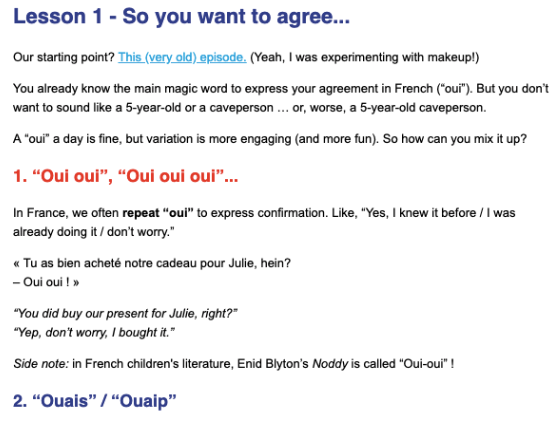
Each e-mail includes a link to one of her videos + specific written explanations you can use for reference.
Building out a Nurture Sequence like this can take time, but once you’re attracting tens or hundreds of new e-mail subscribers to your business every day it becomes worth it, as you can take your new readers from “just finding out about you” to “knowing you, liking you, trusting you, and being ready to buy from you”, which makes selling your first product or service to them a lot easier, WHILE also sharing your most valuable content with them.
Strategy #10: HUB Pages
The final inbound content promotion strategy you can use are so-called “HUB Pages”. HUB Pages are pages on your website that serve as “hubs” that lead to your other content.
One simple example is Derek Halpern’s HUB Page for creating online courses, where he links to some of his most popular articles about creating online courses:
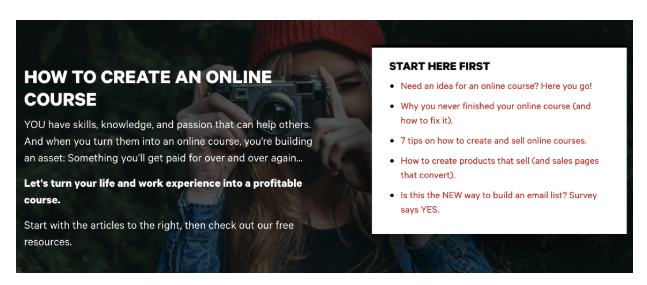
Derek then links to his HUB Pages from the menu at the top of his website:
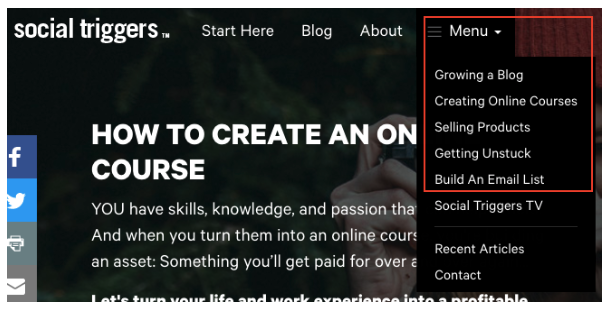
Another example is the HUB Page for this guide, where I link to the specific chapters in this guide.
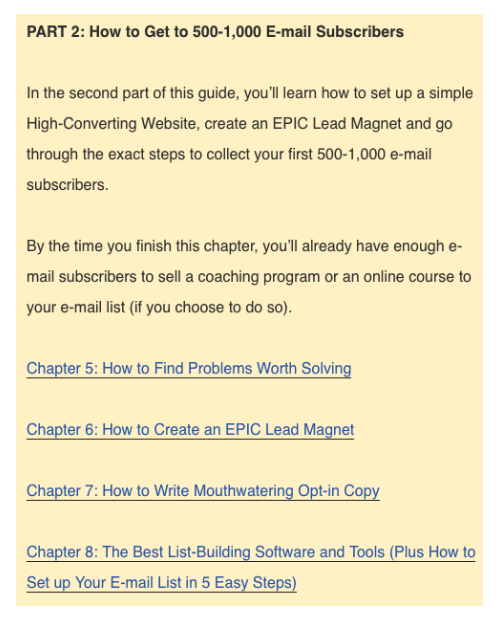
This helps me organize all of my content around a topic like building an e-mail list in one simple page that my readers can visit and return to to find all of my relevant articles.
Every time you notice you’ve written 5+ articles about a popular Problem Worth Solving for your audience, you can create a HUB Page that then makes those articles easy to find for your new (and existing) readers of your audience.
You can then keep updating your HUB Page with new, relevant content every time you create it and build out a true Wikipedia page.
Outbound Short-Term Content Promotion Strategies
Ok, let’s move on to the outbound content promotion strategies. These strategies will help you attract the NEW readers to your website in different, creative ways.
We’ll start with the “low hanging fruit” – the short-term strategies:
- Strategy #11: Close the Loop
- Strategy #12: Simple Share
- Strategy #13: Social Media Share
- Strategy #14: Promo Video
- Strategy #15: Email Everyone
Let’s cover these one by one.
Strategy #11: Close the Loop
If you followed my advice and ran list-building experiments in different online communities, promoting your Epic Lead Magnet or Remarkable Content authentically becomes REALLY easy.
You can simply go back to the people that said they were interested in hearing from you, “close the loop” and share your content with them.
That’s exactly what Michelle Rebosio did to build an e-mail list of 1,000+ e-mail subscribers in under 30 days.
When she validated her business idea, she went into different Facebook Groups about International Development and asked the members of the groups if they would be interested in reading “The Ultimate Guide to Finding a Job in International Development” (which later became her Epic Lead Magnet).
In one of the groups, she received 500+ comments on her post saying they would read the guide.
Once she wrote her guide, she simply went back to that post, and “closed the loop” with everyone who commented on the post, sharing the link to her guide, and her e-mail subscribers started pouring in.
If you experienced a Moment of Traction like Michelle and a lot of people said they wanted to learn about a specific topic from you, go back and reach out to those people and let them know that your resource is finished.
You could do that by:
- Commenting on the old post in the community where people expressed interest in the resource
- Creating a new post in the community, and referencing / linking the post where 100+ people said they would read the resource
- Reaching out to everyone who commented on the post individually and sending them a link to your Epic Lead Magnet
Here are some simple sample scripts you can use for each of these approaches:
Commenting on the old post:
“Hey everyone,
I’m super excited to announce that my Ultimate Guide to Growing Your E-mail List is finished!
Thank you for all of your support and suggestions for what to include in the guide, this guide wouldn’t happen without you.
You can read the guide through this link: [LINK TO GUIDE]
Enjoy!”
Creating a new post:
“Here’s the Ultimate Guide to Growing Your E-mail List that you asked for!
Hey everyone, back in March, I asked you if you wanted to read an Ultimate Guide to Growing Your E-mail List, and 100+ of you said YES: [LINK TO INITIAL POST]
After working on this guide for over 100 hours, I’m super excited to announce that the guide is finally finished!
You can read the full guide through this link: [LINK TO GUIDE]
Enjoy!”
Sending a private message:
“Hey NAME,
It’s Primoz from [COMMUNITY]. Back in March, you commented on this post and told me you wanted to read The Ultimate Guide to Growing Your E-mail List once it’s finished: [LINK TO INITIAL POST]
I just wanted to let you know that after working on it for 100+ hours, the guide is now finished! You can find it here: [LINK TO GUIDE]
Enjoy, and have an awesome day!”
Either of these approaches can work – pick one that feels best to you and share your content with people who asked to read it :).
Strategy #12: Simple Share
When Michelle Rebosio published her Ultimate Guide and built an e-mail list of 1,000+ e-mail subscribers in under 30 days, she didn’t JUST use the Close the Loop technique.
She also went into 40 other relevant Facebook groups and shared her guide there. She really took “shouting it from the rooftops” to heart, and it worked.
In some groups, her guide didn’t get much attention. In others, it brought her 300+ e-mail subscribers, and she keeps getting new e-mail subscribers through it until this day.
In the groups where she didn’t Close the Loop, she used an even simpler strategy: The Simple Share.
She simply went into the groups and shared her guide with a message like this:
“Hi, I recently wrote a guide about finding a job in International Development. You can find it here: [LINK]”
Because her guide was so remarkable and well-written and nobody was really doing what Michelle was doing in her industry, the people in the communities loved it, read it, and shares it with others. That’s the power of choosing an amazing business idea.
Karen Dudek-Brannan also used the Simple Share Strategy to go from 0-186 e-mail subscribers with a single blog post. She wrote a blog post about a Problem Worth Solving for her audience, shared it in a Facebook group, and her e-mail list exploded overnight, even before she had an Epic Lead Magnet or Mouthwatering Opt-in Copy.
When you create truly stellar content, sharing it doesn’t have to be particularly complicated. It can be as simple as saying “I spent a ton of time creating this amazing resource, and I’d like you to have it”.
Alternatively, you COULD write a longer post about your resource that explains why it’s worth reading (this is especially crucial in communities that require you to write extremely valuable posts).
Here’s an example of how I did that recently as I shared my Ultimate Guide to Creating Content That Sticks in an online community I was a part of for years:
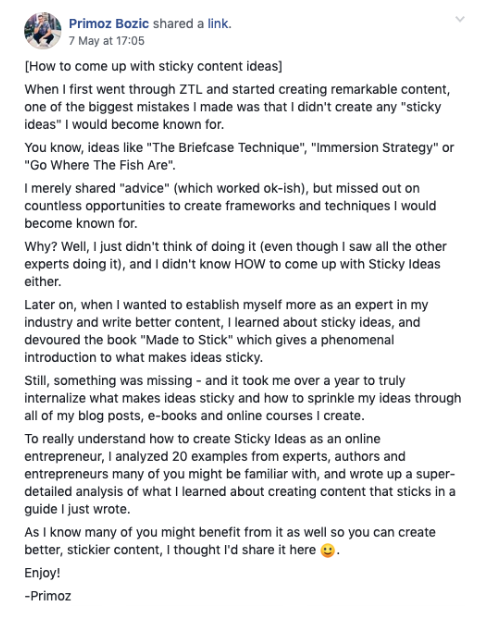
Notice how I talked about the Problems Worth Solving (being known for content, not knowing how to create sticky ideas), shared my Journey (analyzed 20 sticky ideas) and talked about what I learned (a super detailed analysis of sticky ideas).
If you choose to go with a longer version of the Simple Share, mention:
- What the resource you created is
- Which problem it solves
- The work you put into it
- Why you’re sharing it in this community
- How it will benefit the members
And then attach a link to the resource at the end of the post.
Here are a few additional tips on sharing your content through Facebook groups and other communities, if that’s a content promotion strategy you choose to use.
We talked about a lot of these with Sara Kirsch, who grew her e-mail list to 1,000+ subscribers largely through Facebook groups.
- Always read the community guidelines: Some online communities will not allow you to promote your content in them. To be sure, always read the community guidelines first and act in line with them.
- Use dedicated promo threads: Some communities offer specific threads for promoting your content – share your content there.
- Do your research: Don’t just go into communities and ASSUME people want to see your content. Instead, see if they’re asking questions about the Problems Worth Solving you address in your content, and point to them.
- Make friends with community moderators and administrators: Message them, introduce yourself, notice you saw that the members have problems you can help them solve, and find ways to cooperate on doing that.
- Be respectful, positive and provide value: If someone asks a question, do a bit of research, share an idea with them, or bring other people into the conversation. Answer questions as simply as possible. Mention WHAT the solution is and WHY you recommend, and offer to answer additional questions.
- Reach out to admins on a regular basis: Ask them if there’s anything #2 – reach out to admins on a regular basis, ask them “I love this community, is there anything I can help you with?” and make them feel special.
- Be interactive: Reach out to the community members and offer additional help to them. Say “I saw you have this problem, I’d love to help you”, and offer them extra advice.
- Don’t seek customers: Never go into an online community to fish for clients (not cool) or JUST to grow your e-mail list. Your first intention should always be helping people and connecting with them.
- Don’t offer commentary that isn’t useful: Whenever you comment on something, focus on being positive, encouraging, supportive and provide value (rather than being negative and bringing people down)
- Don’t spam: Never go into groups just to “spam” and share every piece of content you write. Only promote your best pieces of content through Facebook groups, and make sure you spend just as much time (if not more) helping community members as you do promoting your content.
You should also read this post from my friend Diana Tower on how to promote yourself through Facebook groups – she provides a different philosophy as a community manager of popular business online communities, and it’s well worth reading.
Strategy #13: Social Media Share
One of the simplest ways in which you can promote your content is by posting it on your social media platforms, like your Facebook wall.
This CAN help you generate some traction around your content under the following circumstances:
- You’re really sharing an EPIC Lead Magnet or a Remarkable Piece of Content
- Your have a lot of Facebook friends that are also your readers / in your target audience
If you’re just sharing a regular blog post you wrote, chances are you won’t see much traction through this approach.
The same goes for not having a lot of friends / followers yet that are in your target audience. If I teach how to play guitar but none of my Facebook friends want to learn how to play it, it’s unlikely that sharing my content there will generate much traction there.
You’ll very quickly see how well this strategy works for you, and then decide if you want to keep doing it or not.
I do share my content (only) on Facebook as that’s where I’m connected with many online entrepreneurs, and my Ultimate Guides tend to generate a lot of traction there.
Here’s a recent example of a post I wrote about my Ultimate Guide to Creating Content That Sticks:
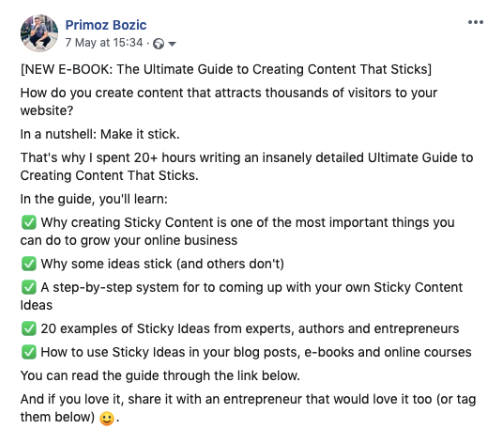
It’s similar to the “Simple Share”, and focuses on Problems Worth Solving, Tangible Outcomes and Building Blocks of my Epic Lead Magnet.
This post got a lot of traction and helped generate hundreds of e-mail subscribers through people reading and sharing the guide.
One thing I like to do whenever I publish an incredible piece of content I spent 20+ hours putting together is to also tag 10-20 specific friends in a comment of the post that would benefit from reading it (or know people who would).
I only do this with my best content once every few months, but I find that it helps create extra buzz and traction.
Strategy #14: Promo Video
If you want to get a bit more creative with content promotion, you could record a promo video / trailer for your Epic Lead Magnets, like Sam Gavis-Hughson:
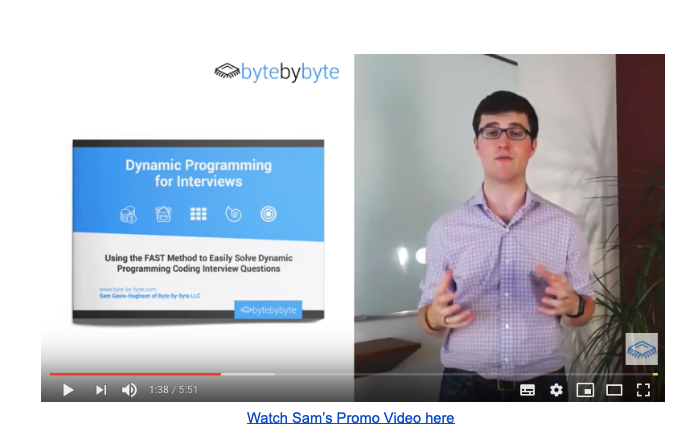
In the video, Sam talks about The Problems Worth Solving:
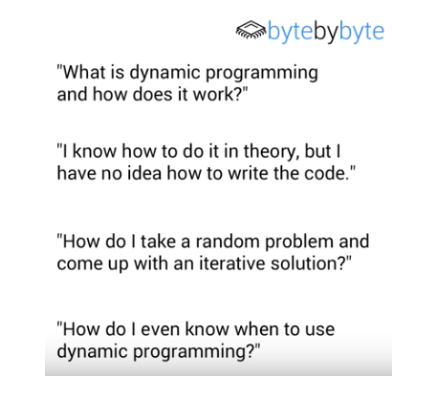
Then, he introduces his new e-book:
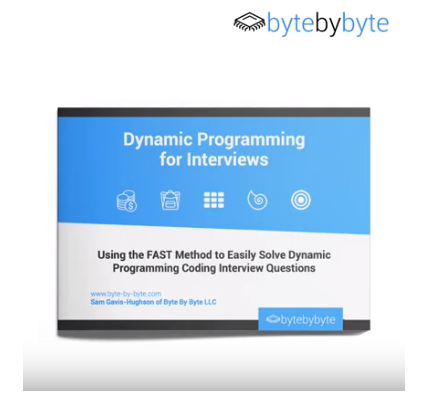
He continues to talk about his FAST Method, a Sticky Idea that is a Building Block of his e-book.
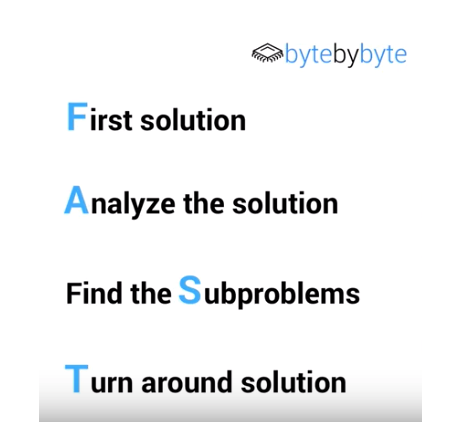
Briefly mentions that the e-book is completely free:
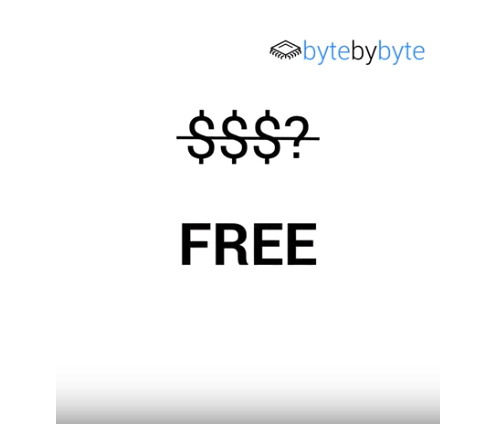
And finally, links to the landing page where you can download his e-book.
Pretty cool huh?
You could create a similar video for your Epic Lead Magnets if you use a YouTube Channel to distribute your Remarkable Content, or even play around with sharing a video like this as a Facebook video to attract new readers.
Strategy #15: Email Everyone
The final strategy comes from my Q & A session with SEO expert Neil Patel, where I asked him how he promoted his ultra-popular Ultimate Guides.
He said:
“You need to get the word out there for the guide to do well, and this indirectly helps you get more links to your guide. You want to send your guides to everyone you’re connecting with on the social web. I’m not talking about just posting them on Facebook and LinkedIn, I’m talking about direct messaging every single person you know and saying ‘Hey so and so, thank you for being a friend, I just wrote this guide, feel free to go here and check it out.’ That drives a lot of traffic when the guide first comes out.”
This one is simple. When you spent 20, 50 or 100+ hours creating something incredible that you really believe will help people, you can e-mail everyone you know about it (private messages via Facebook work too)
You could e-mail:
- Your friends that would be interested in the subject (or know anyone that would be)
- Specific readers / e-mail subscribers / clients that would love it
- Your mentors or coaches
- Any other people you’re connected with in your industry
I suggest e-mailing everyone that already personally know and you have a reasonably strong relationship with. If you think about them receiving the e-mail from you and think “they’d love to read this”, you should email them.
If you’re in doubt, don’t.
As you do this, it’s usually nice to include a personal message that makes the other person FEEL really amazing as they see it.
For example, if someone e-mailed me, I would love if they said something like “Hey Primoz, how are you?? I’m really enjoying your list-building guide, it’s awesome! I really love [CHAPTER] because of [REASON], nice work man!!”, it would make me smile.
It could also be a personal message about something you talked about recently (“how did your powerlifting competition go?” or “did you end up finding any awesome omelette recipes?”).
I try to make these messages genuine and as long as they need to be, as I’m not reaching out to my network just to promote my content, but also to connect with them.
You can use the script below to reach out to your network and share your content with them in a non-spammy way:
“Hey NAME,
[Insert Personal Message]
Over the past few months I wrote this super detailed [Ultimate Guide Title] – and I thought I’d send it your way because you might enjoy it (or know someone who does).
Have a great week!
-Your NAME”
Here’s an example of a simple e-mail that I sent to a friend when I wrote one of my guides (no personal message on this one as we just talked the previous day, so I just wanted to keep it clear and to the point):
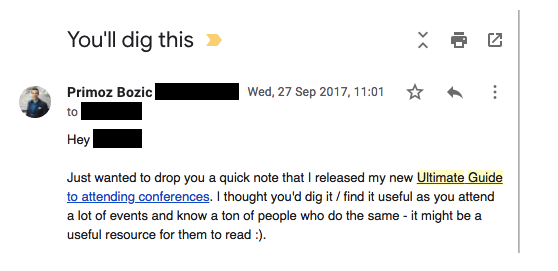
I definitely don’t use this strategy every time I publish a piece of content, but I do it every time I write an Ultimate Guide I spent 50+ hours writing.
Outbound Long-Term Content Promotion Strategies
Woohoo! We’re almost crossing the finish line – just 6 outbound long-term content promotion strategies to go!
These strategies will help you add new stream of readers to your website for years to come. They’re also a bit more time consuming and strategies you’ll use over and over again in your business.
Here they are:
- Strategy #16: Guest posting
- Strategy #17: Partnerships
- Strategy #18: Podcasts & summits
- Strategy #19: FAQ sites
- Strategy #20: Casual mentions
- Strategy #21: Public speaking
Strategy #16: Guest Posting
Guest posting on other notable websites in your industry seems to be a popular option for promoting your content, especially in the earlier stages of growing your e-mail list:
- Nagina Abdullah used guest posting as a primary content promotion strategy to grow her e-mail list to 5,000+ e-mail subscribers
- Peter Nguyen jump-started his e-mail list growth by attracting 1,000+ e-mail subscribers through a single guest post
- Rusty Gray got 400+ e-mail subscribers with one of his guest posts
- Danny Margulies and Olivia Angelescu also used guest posting as go-to content promotion strategies to grow their e-mail lists
Guest posting can be a great way of promoting your content and growing your e-mail list if:
- You really enjoy writing
- There are a lot of websites in your industry
- You already have a decent network
But there’s also a danger of being stuck in Endless Pitching, where you send out tens of guest post pitches but rarely hear back (and spend more time waiting on answers than growing your e-mail list).
We’ll dive into Guest Posting in more detail in a dedicated chapter of this guide as it’s such a deep topic (as we can talk about which websites to pitch, how to pitch them, how to write a great guest post, etc.), but for now, know that it’s a great option for promoting your content.
Here’s how you can use guest posting to promote your content (we’ll look at the guest post from Peter Nguyen that got him over 1,000 new e-mail subscribers):
Step #1: You write a guest post for a popular website in your industry
Peter wrote an Ultimate Guide to Buying a Leather Jacket:
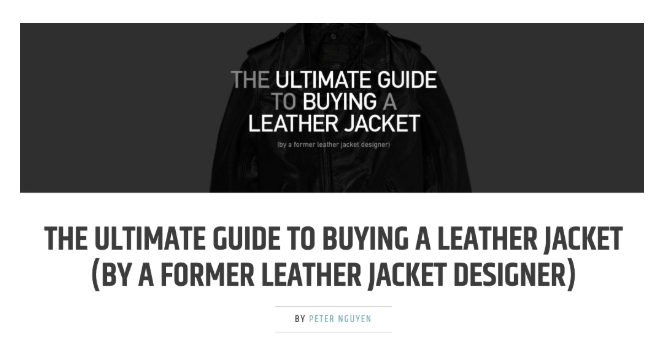
Step #2: Offer a RELEVANT BONUS at the end of your guest post
Peter offered the readers a PDF version of the guide and a printable shopping checklist for buying a leather jacket (super relevant!):
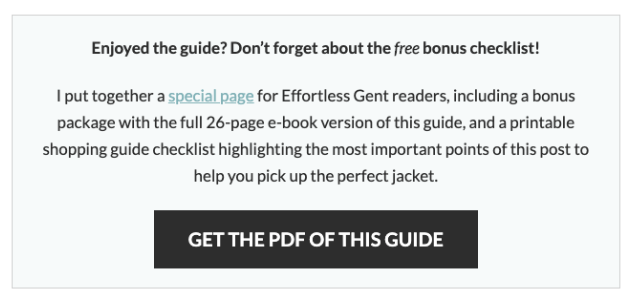
Step #3: Create a dedicated Lead Magnet Page on your website
Finally, he created a special Lead Magnet Page for readers of the guest post:
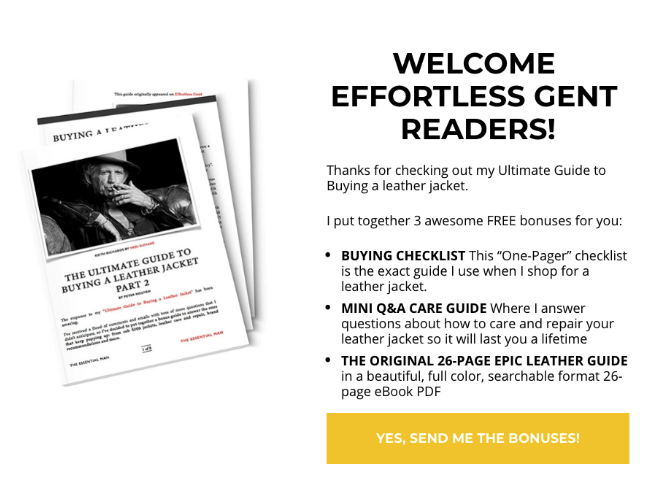
And attracted 1,000+ new e-mail subscribers to his website within 30 days of publishing the guest post (plus hundreds more over the years as his article ranks really high on google for “how to buy a leather jacket”).
Strategy #17: Partnerships
There are other ways of partnering up with other bloggers or websites in your industry to create WIN-WIN Partnerships.
Nagina Abdullah used partnerships as one of the key strategies to grow an e-mail list of over 16,000 e-mail subscribers:
“I reached out to people with complementary audiences, sent them an e-mail, and said “I love what you’re talking about, I want to share your message with your audience, is there a way for us to work together?”, and we got on a phone and made it happen.
It could be a joined webinar, we could share our lead magnets with each other’s e-mail lists, or write guest posts for each other.
These partnerships were really powerful because I could get 30, 100, or even 200 e-mail subscribers per person, and if I really focused on it, I could get 1,000+ subscribers within a month.”
Partnerships will become relevant to you when you already have a decent audience, and you should try to partner up with entrepreneurs with similar audiences as you have.
For example, if you have 1,000 e-mail subscribers, you could partner up with an entrepreneur that also has 1,000 e-mail subscribers. If you have 5,000, find someone that also has around 5,000 e-mail subscribers.
Find people with similar messages whose work you believe in, and help each other grow your e-mail lists.
The beauty of partnerships is that you can do them in so many different ways and always find something that works for you:
- If you love writing, do guest posts
- If you prefer speaking, do a joined webinar
- If you want to do something quickly, share a lead magnet with each other’s audience
- If you have a YouTube channel, do a collaboration
- If you want to take things further, you could even do an affiliate launch
If you love collaborating with other experts and there are plenty of experts in your industry, partnerships can be a great way to continue growing your e-mail list.
Strategy #18: Podcasts & Summits
Another strategy that Nagina Abdullah used to get the word out about herself and her website and build an e-mail list of 16,000+ e-mail subscribers was being a guest speaker at podcasts and summits.
She was a guest at podcasts in both the Health and Fitness and Business industries. She went on Business podcasts because she felt like she had a lot to say about entrepreneurship, and her audience listened to business podcasts.
She developed a system for doing that, reached out to 5 podcasts/week for months, and eventually hired a Virtual Assistant to pitch for her, so she could focus on other parts of her business.
She is also a regular guest at online summits (online conferences that last for 3-21 days and host up to 30 experts).
She would appear on these summits, send out 1-2 e-mails to her e-mail list about them, and talk about her appearance on the summit. She would then do the interview and offer a free gift to the viewers of the summit (similarly to how you would offer a bonus to your guest post readers) to grow her e-mail list.
Through being a guest at these summits, she on average attracted 60-75 e-mail subscribers, with some of them bringing as many as 800-1,000 e-mail subscribers to her website.
To find summits to speak at, she would find past summits in her industry online, ask the host if they’re doing any future summits, and offer to speak at them. Now she speaks at a summit every 6 weeks or so.
Being a guest speaker at podcasts and summits is a great way to get your content out into the world (as you’ll always mention your Epic Lead Magnets at the end of the interviews or even throughout them) and grow your e-mail list, especially if you prefer talking to writing.
Similarly to guest posting, being a guest on podcasts is a subject that would require it’s own chapter of the guide, which I might add to it later (to talk about which podcasts to pitch, how to best pitch them, how to grow your e-mail list through them…).
If you’d like me to write a more detailed chapter about podcasts (or other strategies from this chapter), please do leave a comment below this one to let me know!
Strategy #19: FAQ Sites
Next up, we have FAQ sites like Reddit and Quora where people go to get ask questions about various topics, including Problems Worth Solving.
Jesse Gernigin built an e-mail list of over 750 e-mail subscribers through answering questions about freelancing and Upwork on Quora:
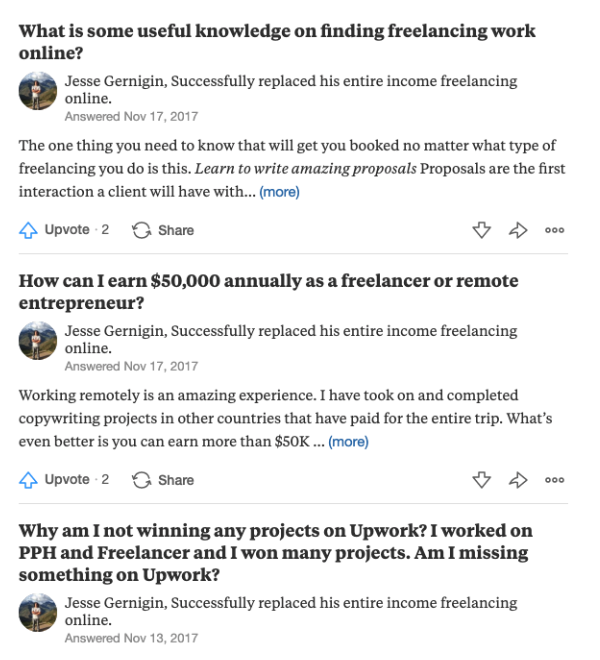
He simply wrote really detailed answers to the questions he felt he was capable of asking really well, and promoted his Epic Lead Magnet (an Ultimate Guide to Booking Your Schedule Full) at the end of his posts:
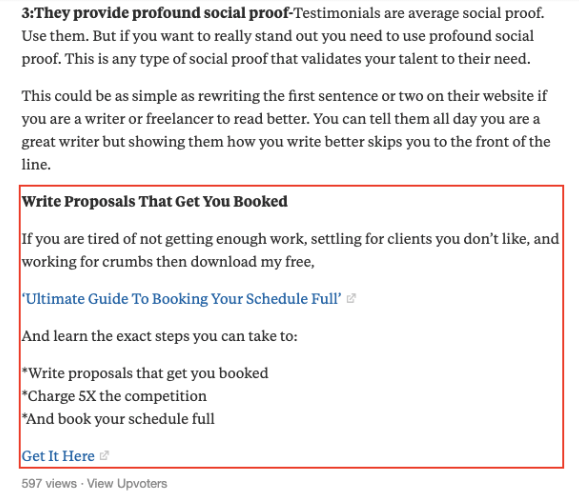
FAQ sites (especially Quora) can be a great way to collect targeted e-mail subscribers if you love answering questions and writing the best answers to them.
The key things to keep in mind when answering questions on a platform like Quora are:
- Make sure that the questions you are answering are actually related to your Epic Lead Magnet (you probably shouldn’t answer questions about fat loss and then link to an e-book about building habits)
- Take the time to write the best possible answers, to make sure they get noticed and stand out from all other answers
- Always include your Epic Lead Magnet in your answers, and tell the readers why they should download it (mention the Tangible Results or Problems Worth Solving)
Another FAQ site that you could use to promote your content is Reddit, though I will say that Reddit serves more as a closed community, and some of the “subreddits” (the mini-communities related to specific topics on reddit) are against any sort of content promotion.
For example, both Sam Gavis-Hughson and Will Darling got banned from reddit when they tried to share their lead magnets there, even though they did it in a way that added value to the community.
Possibly the best approach to take in Reddit groups is to use the “Closing The Loop” strategy. If you asked a question on Reddit that got a huge response and a lot of redditors shared problems worth solving, you could create a free resource that addresses those questions and leave it as a comment on the original thread.
You could also apply this technique to any industry-specific FAQ sites and any online forums in your industry, and as you do, keep this in mind:
Always read the forum / community guidelines and act in line with them.
That’s the best way to authentically promote your content through them without getting banned.
Strategy #20: Casual Mentions
Another simple long-term strategy you can use are what I call “Casual Mentions”.
You can casually mention your best content where-ever relevant: in your content, partnerships and conversations.
For example, you might mention your content when:
- You’re writing a guest post (you can link to a relevant resource within the guest post)
- You’re speaking at a podcast or a summit (the host will usually add any resources to the show notes)
- You’re writing your own blog posts or creating YouTube videos (this is similar to the Wikipedia Strategy)
- You’re having casual conversations over Skype, at conferences, masterminds, meet-ups…
It’s always great to keep sharing your best content with people that are interested in it.
Strategy #21: Media Publications
One final content promotion strategy you can experiment with is getting featured in large media publications like Business Insider, Entrepreneur and Forbes.
If you write an article or get profiled in one of those publications that takes off, you could attract hundreds or thousands of new e-mail subscribers to your business.
This happened to Danny Margulies, who wrote an article for Business Insider about his freelancing journey:
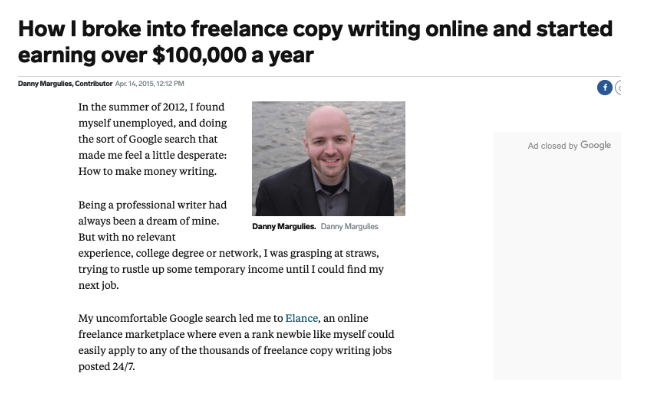
“I saw they wrote an article about a freelancer traveling the world. I looked up the person that wrote the article, and sent them an e-mail with a catchy subject line (“0-6 figures freelancing story”).
I told them I read their article and had a similar story with a different angle (I made 6 figures while working from home). They wrote back to me and asked me to write the article for them.
I had a similar experience with Business Insider. I was profiled there because of my online business success, and attracted 1,000+ e-mail subscribers to my business in less than a month.
Especially if you have an amazing story or a personal transformation that could go viral, finding ways to reach out to the media can help you put your business in front of a lot more people.
My friend Selena Soo is an expert at helping entrepreneurs get more publicity for their business, so if you’re interested in learning more about how to get featured in top publications, I’d definitely follow her and check out some of her content as well as her online course Impacting Millions.
“What about influencer marketing, backlinks or Facebook Ads?”
Three content promotion strategies I didn’t mention but many “internet marketers” recommend are:
- Influencer marketing: Asking influencers to share your content
- Backlinks: Asking bloggers to link to your content
- Facebook Ads: Paying for traffic to your content
Here’s why I didn’t recommend any of those strategies.
The first reason is that almost none of the entrepreneurs I interviewed for this guide used those strategies to build their e-mail lists of 1,000-40,000 people (and neither have I). That’s why I couldn’t make great recommendations around them, and this data also shows that they’re not necessary for building your e-mail list.
The second reason is that I believe that you should be able to attract traffic to your website organically, without paying for it, using the strategies in this guide. Avoiding the hard work and trying to “pay your way” into solving your traffic problems will more often than not result in flushing money down the drain.
Will Darling told me he wasted over $5,000 trying to figure out the Paid Traffic game, and he’s not alone. I heard A LOT more horror stories than success stories with using Paid Advertising BEFORE figuring out the Organic Traffic game.
Even Nagina Abdullah who used the majority of the strategies in this chapter (Guest posting, Publicity, Social Media (FB, IG, LinkedIn), FB ads, Podcasts, Summits, Partnerships and SEO, which we’ll touch on in a future chapter of this guide) said that Facebook Ads worked, but only worked for a while.
The final reason is that I’m not a believer of reaching out to people you don’t know and asking them to share your content without building a strong relationship first (and unfortunately, that’s what those strategies are about).
To me, saying “hey I saw your blog post, it’s awesome, will you share my blog post?” feels way too transactional, and even if it “works”, that’s not how I like to run my business.
I’d rather build genuine relationships with top experts in my industry than to ruin my chances of building a relationship with them by e-mailing them and asking them to share my content.
Summary: How to Promote Your Content: An In-Depth Guide
In this chapter, we covered A LOT, and I hope it will serve you as THE reference guide for promoting your content.
First, we talked about when and if you should promote your content, and concluded that you should ask yourself the following 7 questions to make the right decision:
- Is content promotion my strength or weakness?
- How big is my existing network?
- How big is my e-mail list?
- How EPIC is my content?
- What is my main content platform?
- What kind of results am I getting from content promotion?
- Can I create a snowball effect?
Then, we dove into 21 content promotion strategies, which we organized into 5 different categories:
- Meta-Strategies: Strategies you should always keep in mind when promoting your content
- Inbound Short-Term Promotion: Quick & easy strategies to promote your content to your EXISTING audience
- Inbound Long-Term Promotion: In-depth strategies to promote your content to your EXISTING audience
- Outbound Short-Term Promotion: Quick & easy strategies to reach NEW audiences
- Outbound Long-Term Promotion: In-depth strategies to reach NEW audiences
We organized these strategies into the Content Promotion Matrix:
And went over each of the 21 strategies in detail:
Meta-Strategies:
- Be so good they can’t ignore you: 90% of the work is creating content that is so good that people will promote it FOR you
- Shout it from the rooftops: When you create an EPIC piece of content, talk about it everywhere and to everyone
- The 80/20 Rule of Content Promotion: Find the 20% content promotion strategies that bring you the best results, double down on them and ignore all others
Inbound Short-Term Promotion:
- Welcome E-mail: Include your Epic Lead Magnets and your best content in your Welcome E-mails
- High-converting website: Make sure your best content is the front and centre of your website and can be accessed in 1-2 clicks
- List Launch: Always launch your content to your e-mail list through a single e-mail launch (most blog posts), a 5-day launch (Epic Lead Magnets you spent 20 hours creating), or an EPIC launch (content you spent 100+ hours creating)
Inbound Long-Term Promotion:
- Wikipedia strategy: Turn your website into an interconnected wikipedia page of your content (keep linking to old content and updating your old content with links to new content)
- Cliffhangers: Create cliffhangers in your blog posts / YouTube videos and offer Relevant Lead Magnets at the end of them
- Nurture sequence: Once you have thousands of e-mail subscribers and at least 10-20 pieces of Remarkable Content, create a nurture sequence to e-mail your best content to new subscribers over the course of 5 days
- HUB pages: Create HUB Pages on your website around major Problems Worth Solving that link to all relevant articles / videos you created on those topics
Outbound Short-Term Promotion:
- Close the loop: Every time you run list-building experiments in online communities, Close The Loop with people who wanted to read your Epic Lead Magnets and share them with them
- Simple share: Share your best content in online communities that allow content sharing, in a way that adds value to the communities
- Share on social media: Share your content through your social media channels (and tag people in your best content posts that would love reading them)
- Promo video: Create a promo video for your Epic Lead Magnet and publish it on YouTube or Facebook
- Email everyone you know: Every time you spend 50+ hours on a piece of content, e-mail it to everyone in your network that would benefit from it (or that might know someone that does)
Outbound Long-Term Promotion:
- Guest posting: If you love writing, write guest articles for popular websites in your industry
- Partnerships: Partner up with bloggers with similar audience sizes and create joined webinars, exchange lead magnets or guest posts
- Podcasts & summits: Be a guest on summits and podcasts to spread the word about your Epic Lead Magnets
- FAQ sites: Answer questions on websites like Reddit and Quora and mention your Epic Lead Magnets at the end of your answers
- Casual mentions: Casually mention your best content in podcast interviews, any new content you create, or casual conversations with your clients, readers, or people you meet at meet ups and conferences
- Media Publications: If you have a personal transformation or a story worth sharing, try to get it out thorough outlets like Business Insider, Entrepreneur and Forbes
Finally, I explained why I don’t recommend using Facebook Ads, Influencer Marketing or Backlink Strategies to promote your content:
- Very few entrepreneurs successfully used FB Ads to grow their e-mail lists (and the ones that did found that they eventually stopped working)
- You should be able to organically promote your content BEFORE you do paid promotion. If your content doesn’t take off, make it better – don’t throw money at it!
- Influencer Marketing and Backlinking Strategies tend to be spammy and annoying, and won’t give you a good reputation in your industry. Instead, focus on building genuine relationships and turn them into WIN-WIN partnerships
That’s it!
In the next chapter of this guide, we’ll talk about how to create a High-Converting Website – the last piece of the puzzle you need to reach 500-1,000 e-mail subscribers (and grow your e-mail list beyond the magical 1,000 subscriber mark).
Continue to Chapter 11: How to Create a High-Converting Website
Your turn: What’s your favorite way to promote your content?
Are you ready to build an e-mail list of 1,000+ BUYERS?

Download the full 393-page PDF version of this EPIC list-building guide, to print it out or read it on the go!
Woah! That’s a massive chapter!! Took me more than an hour to go through it, Did you know that we usualy remember about 10% of the things we read ? That UG is definitely one that I will read several times to make sure I know this stuff in and out.
Can’t wait to read the next chapter.
Have a nice week-end 🙂
Hey Charles, I’m glad you enjoyed it!
I’ll create a PDF version of the guide once it’s finished so you can read the whole thing, or print it out, and reference it for years to come :).
-Primoz